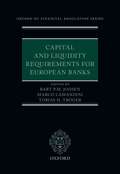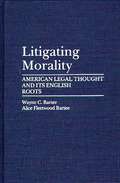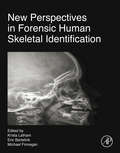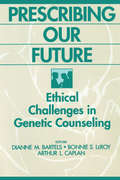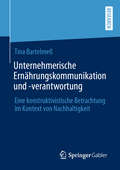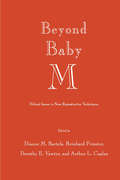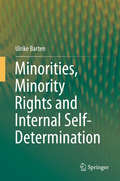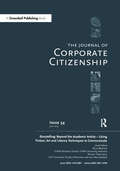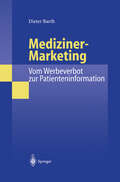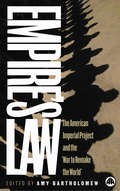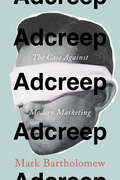- Table View
- List View
Capital and Liquidity Requirements for European Banks (Oxford EU Financial Regulation)
by Bart P.M. Joosen, Marco Lamandini, Tobias TrögerPart of the Oxford EU Financial Regulation Series, this book analyses the harmonised legislative framework for capital adequacy and liquidity supervision in the Single Rule Book for European banks. It brings together leading experts in the field of prudential banking regulation and accounting to provide an in-depth analysis of the regulatory framework. Capital and Liquidity Requirements for EU Banks goes far beyond the existing rules and standards, not only by looking into the historical realisation of the European Single Rule Book (SRB) for capital adequacy and liquidity supervision, but also by going deeply into the background of the standards put forward by the Basel Committee for Banking Supervision, the global rule-maker for the financial sector. The insights provided into the historical and normative background are essential in order to facilitate a more constructive interpretation of the extensive rules of the SRB The book also delivers a deeper understanding of the various policy choices that Europe has made in the transposition of the Basel standards. An important reference source for all legal practitioners and scholars researching European financial regulation, this new volume provides an extensive representation of the key topics, affording the reader unique insights into the interrelation and the interplay of the various prudential rules and standards in Europe.
Litigating Morality: American Legal Thought and Its English Roots
by Alice Fleetwood Bartee Wayne C. BarteeThis volume is a thematic study in legal history that uses past and present landmark court cases to analyze the legal and historical development of moral regulatory policies in America and resulting debates. Using a critical variable approach, the book demonstrates how different elements of the legal process have historically influenced the litigation of various moral issues. Five moral policies are included: abortion, sodomy, pornography, criminal insanity, and the death penalty. The book's framework for analysis uses examples from English legal history and links them to American cases, demonstrating how moral regulatory policies are impacted by the legal process: by laws, by judges and juries, by legal scholars, and by attorneys.Following a brief introduction, Chapter 1 examines how protagonists in the bitter moral and legal controversy over abortion in America have sought to fortify their positions with the views of prominent English legal authorities. The authors discuss the role of English legal scholars in court opinion and oral arguments in Webster and in Roe v. Wade, and debates Roe's interpretation of the English legalists. Chapter 2 describes how attempts to expand a right of privacy under the federal Constitution to include sodomy failed the test for common law rights (Rights of Englishmen) in Bowers v. Hardwick (1986), and includes a history of sodomy in early English and American law. Chapter 3 discusses pornography standards and laws, highlighting the history of legal actions taken against Memoirs of a Woman of Pleasure in both England and the U.S., demonstrating the role of precedent in American judicial efforts to define pornography. In Chapter 4, which deals with the criminal insanity defense, the influential role of the defense attorney on case outcomes is illustrated in cases such as England's McNaughton case (1843) and America's Hinckley case (1982). Chapter 5 deals with cruel and unusual punishment throughout U.S. and English history. The book ends with an epilogue which ties together the idea of the American legal process as an inherited English process, reiterating how decisionmakers continually mine the past to find traditions and sources of moral values for justifying or criticizing current laws and policies.
New Perspectives in Forensic Human Skeletal Identification
by Eric J. Bartelink Krista E. Latham Michael FinneganNew Perspectives in Forensic Human Skeletal Identification provides a comprehensive and up-to-date perspective on human identification methods in forensic anthropology. Divided into four distinct sections, the chapters will reflect recent advances in human skeletal identification, including statistical and morphometric methods for assessing the biological profile (sex, age, ancestry, stature), biochemical methods of identification (DNA analysis, stable isotope analysis, bomb curve analysis), and use of comparative radiography. The final section of this book highlights advances in human identification techniques that are being applied to international populations and disaster victims. The contributing authors represent established experts in forensic anthropology and closely related fields. New Perspectives in Forensic Human Skeletal Identification will be an essential resource for researchers, practitioners, and advanced students interested in state-of-the-art methods for human identification.A comprehensive and up-to-date volume on human identification methods in forensic anthropologyFocuses on recent advances such as statistical and morphometric methods for assessing the biological profile, biochemical methods of identification and use of comparative radiographyIncludes an entire section on human identification techniques being applied to international populations and disaster victims
Prescribing Our Future: Ethical Challenges in Genetic Counseling
by Diane M. Bartells Bonnie LeRoyGenetic counselors translate the findings of scientific investigation into meaningful accounts that enable individuals and families to make decisions about their lives. This collection of original papers explores the history, values, and norms of that process, with some focus on the value of nondirectiveness in counseling practice. The contributors; examination of genetic counseling issues serves as a foundation from which to address other ethical, legal, and policy considerations in the expanding universe of clinical genetics.
Prescribing Our Future: Ethical Challenges in Genetic Counseling
by Diane M. Bartells Bonnie LeRoyGenetic counselors translate the findings of scientific investigation into meaningful accounts that enable individuals and families to make decisions about their lives. This collection of original papers explores the history, values, and norms of that process, with some focus on the value of nondirectiveness in counseling practice. The contributors; examination of genetic counseling issues serves as a foundation from which to address other ethical, legal, and policy considerations in the expanding universe of clinical genetics.
Unternehmerische Ernährungskommunikation und -verantwortung: Eine konstruktivistische Betrachtung im Kontext von Nachhaltigkeit
by Tina BartelmeßTina Bartelmeß untersucht Ernährungskommunikation von Unternehmen der Lebensmittelwirtschaft aus einer sozialkonstruktivistischen Perspektive. Anhand einer empirischen Studie zeigt sie neue Rollen und Funktionen der Ernährungskommunikation vor dem Hintergrund der Ziele einer nachhaltigen Entwicklung des Ernährungssystems auf. Dabei beleuchtet die Autorin insbesondere das Verhältnis zwischen unternehmerischer Verantwortungswahrnehmung und Kommunikation in Bezug auf Nachhaltigkeit. Sie untermauert die Notwendigkeit einer kommunikativen Wende in der Ernährungskommunikationsforschung.
Wild-Tier-Fotografie: Ökologische, postkoloniale und ästhetische Perspektiven (Cultural Animal Studies #15)
by Martin Bartelmus Maurice SaßTechnische Innovationen der Fotografie erlaubten Ende des 19. Jahrhunderts, Wildtiere nicht mehr nur als Kadaver und Beute oder in Studio und Gehege abzulichten, sondern ihnen in ihrem natürlichen Habitat nachzuspüren. Die frühe Wildtierfotografie bediente damit ein populäres Interesse an der als lokal, national oder kolonial geschätzten Fauna, lieferte wichtige Beiträge zur zoologischen Forschung und verstand sich häufig als Vorkämpfer des Naturschutzes. Ganz neu stellte sich damit aber auch die Frage, wie man Tiere richtig fotografiert: technisch, ästhetisch, ethisch. Der Band beantwortet diese Fragen in historischer Perspektive und erschließt damit das Forschungsfeld der Wildtierfotografie.
Beyond Baby M: Ethical Issues in New Reproductive Techniques (Contemporary Issues in Biomedicine, Ethics, and Society)
by Dianne M. Bartels Reinhard Priester Dorothy E. Vawter Arthur L. CaplanArthur L. Caplan It is commonly said, especially when the subject is assisted reproduction, that medical technology has out stripped our morality. Yet, as the essays in this volume make clear, that is not an accurate assessment of the situ ation. Medical technology has not overwhelmed our moral ity. It would be more accurate to say that our society has not yet achieved consensus about the complex ethical iss ues that arise when medicine tries to assist those who seek its services in order to reproduce. Nevertheless, there is no shortage of ethical opinion about what we ought to do with respect to the use of surrogate mothers, in vitro fertil ization, embryo transfer, artificial insemination, or fertil ity drugs. Nor is it entirely accurate to describe assisted repro duction as technology. The term "technology" carries with it connotations of machines buzzing and technicians scurrying about trying to control a vast array of equip ment. Yet, most of the methods used to assist reproduc tion that are discussed in this volume do not involve exotic technologies or complicated hardware. It is technique, more than technology, that dominates the field of assisted reproduction. Efforts to help the infertile by means of the manipu lation of human reproductive materials and organs date 1 2 Caplan back at least to Biblical times. Human beings have en gaged in all manner of sexual practices and manipulations in attempts to achieve reproduction when nature has balked at allowing life to begin.
Arzneimittelsicherheit - Wunsch und Wirklichkeit (MedR Schriftenreihe Medizinrecht)
by H. Bartels I. Dautert L. Hast A. Jorzig U. Winter J. Heynemann R. Mansfeld-Nies Ch. V. Pestalozza T. Porstner V. Saalfrank J. Schoenemann E. Schröder U. SmentkowskiLaut wissenschaftlicher Studien könnten 30 bis 70 Prozent unerwünschter Arzneimittelwirkungen vermieden werden. Strittig ist, ob die Sicherheitsprobleme ausreichend an Ärzte und Öffentlichkeit kommuniziert werden. Die Beiträge des XVIII. Kölner Symposiums der "Arbeitsgemeinschaft Rechtsanwälte im Medizinrecht" schildern die rechtlichen und ökonomischen Anforderungen u.a. an die Entwicklung neuer Medikamente. Ein Arbeitsbuch für die tägliche Praxis.
Military Operations and the Notion of Control Under International Law: Liber Amicorum Terry D. Gill
by Rogier Bartels Jeroen C. van den Boogaard Paul A. L. Ducheine Eric Pouw Joop VoetelinkThis book is a tribute to the work of Professor Terry Gill, offered to him by friends and colleagues who are also academics and/or practitioners in the field of International Law of Military Operations (ILMO).ILMO is a distinct sub-discipline within public international law and domestic public law, covering all domains of military operations: land, sea, air and (cyber)space. As such, ILMO includes elements of other branches of public international law, such as international humanitarian law, human rights law, the law on the use of force, the law of the sea, the law of State responsibility, arms control law and the law of international organisations. Importantly, as a hybrid field of law, ILMO covers the legal basis for military deployment both nationally and internationally, as well as the subsequent international legal regimes applicable to the forces (once deployed) and the domestic administrative and constitutional issues related to the relevant forces.Control is a central notion of ILMO and is the leading theme of this book. The contributions in this book reflect the variety of legal frameworks applicable to military operations and offer an insightful view into the various legal and factual roles of control. The legal notion of control is considered, inter alia, in relation to restraints in the decision to deploy military forces and the legal basis for doing so. The impact of control is also discussed in relation to State and command responsibility and in different situations, including during peace operations, occupation and other situations of armed conflict. Additionally, control is considered over the armed forces themselves, over detainees migrants at sea and over the type or scale of force used in military operations, through targeting rules or rules of engagement. Furthermore, the book contains several discussions of control in the case law of international courts, within arms control law, weapons law and in the context of autonomous weapons systems.The editors of the book are all practitioners, academically affiliated to the Faculty of Military Sciences (War Studies) of the Netherlands Defence Academy and/or the Law Faculty of the University of Amsterdam.
Rechtsfolgen der Manipulation bei juristischen Prüfungen (Reihe Rechtswissenschaft)
by Bettina BartenMinorities, Minority Rights and Internal Self-Determination
by Ulrike BartenThe book questions the classic idea of self-determination – the right to self-determination is a right of peoples, not of minorities – by examining the content of the right to self-determination and the content of minority rights. Self-determination has four dimensions: the political, the economic, the social and the cultural dimensions. Minorities have minority rights that touch on most aspects of life as a member of a minority. If there is an overlap between minority rights and the different dimensions of self-determination, the concept that the right to self-determination is only applicable to peoples loses credibility. No global and general conclusion is envisaged; there are restrictions in place. The work is limited to the European framework and is further restricted to classic minorities. The argument is based on a legitimacy and justice approach. The analysis in this book shows that some minority rights overlap with the different dimensions of internal self-determination. In short, classic minorities in Europe have a right to internal self-determination.
Storytelling: A special theme issue of The Journal of Corporate Citizenship (Issue 54)
by Nick Barter Helen TregidgaHow can we tell our stories differently? How can we go beyond the academic article or sustainability report? All reports and all scholarly pieces are narratives of a sort, each choosing which evidence suits and each having some sense of beginning, middle and end.Through their use of fiction, art and poetry the seven papers in this Special Issue of The Journal of Corporate Citizenship are challenging what might typically be expected as the form of an academic article. These challenges include identifying silent voices, linking of our hands, hearts and heads via art, a poem, a napkin to communicate, the life of an average academic, stories of gladiatorial combat for promotion, and a man’s day in a non-specific future. This mix of challenge in both form and message contributes to the ability of the papers to advance understanding, and reinforces how an innovative approach to conveying the message can advance debate.
Mediziner-Marketing: Eine rechtsvergleichende und interdisziplinäre Studie zur Kommunikation zwischen Patienten und Ärzten
by Dieter BarthRethinking Bank Regulation: Till Angels Govern (PDF)
by James R. Barth Gerard Caprio Ross LevineThis volume assembles and presents a database on bank regulation in over 150 countries (included also on CD). It offered the first comprehensive cross-country assessment of the impact of bank regulation on the operation of banks, and assesses the validity of the Basel Committee's influential approach to bank regulation. The treatment also provides an empirical evaluation of the historic debate about the proper role of government in the economy by studying bank regulation and analyzes the role of politics in determining regulatory approaches to banking. The data also indicate that restrictions on the entry of banks, government ownership of banks, and restrictions on bank activities hurt banking system performance. The authors find that domestic political factors shape both regulations and their effectiveness.
Führung in Verwaltung und Polizei: Eine soziologisch informierte Ermutigung
by Christian BarthelDieses Fachbuch hilft dabei, die komplexe und oft anstrengende Wirklichkeit des Führungsalltags und theoretisches soziologisches Wissen in ein ausbalanciertes Verhältnis zu bringen. Zunächst werden die organisationssoziologischen Grundlagen einer Theorie der Führung beschrieben, dann wird die praktische Arbeit der Führung im Organisationsalltag der Verwaltung fokussiert. Dies geschieht unter dem Gesichtspunkt des Managements kritischer Führungssituationen. Deutlich wird dabei, dass die durchgehende Aufmerksamkeit für kritische Situationen nicht als punktuelle Reparaturarbeit missverstanden werden darf, sondern als der systematische Weg zu einer prozesshaften Dienststellenentwicklung verstanden werden muss. Außerdem wird der Blick auf die Führungsinteraktion im engeren Sinne gewendet – also auf die Personalführung, aber auch auf die gleichermaßen relevanten Interaktionen mit ebenengleichen Kollegen, Vorgesetzten oder externen Anspruchsgruppen bzw. Kooperationspartnern. Schließlich wird das Selbstmanagement der Novizen im Höheren Dienst in ihrer neuen Führungsrolle beleuchtet.Der Autor nutzt seine persönlichen Erfahrungen als Führungspraktiker und als Dozent für Führungslehre und verdichtet und reflektiert sie für „Aufsteiger“ vor allem in den Höheren Dienst der allgemeinen Verwaltung sowie der Polizei aus organisationssoziologischer Sicht.
Managementmoden in der Verwaltung: Sinn und Unsinn
by Christian BarthelManagementmoden kursieren schon seit langem in der Verwaltung – nicht erst seit dem New Public Management. Der vorliegende Band stellt aktuelle Konzepte vor, die in den letzten 10 Jahren Konjunktur hatten und haben. Die besprochenen Konzepte werden vor einem zumeist organisationssoziologischen, aber auch verwaltungswissenschaftlichen und psychologischen Hintergrund diskutiert. Damit werden auch die blinden Flecken, d.h. die verkürzten theoretischen Grundannahmen sowie die teilweise ideologische Vollmundigkeit der Konzeptangebote auf- und abgeklärt. In einem zweiten Abschnitt wird – gewissermaßen als Gegenmittel zu den verkürzenden Managementmoden – theoretisches Rüstzeug unterbreitet, das für die Praxis eine robustere Orientierung bieten kann.
Polizeiliche Gefahrenabwehr und Sicherheitsproduktion durch Netzwerkgestaltung: Eine Aufgabe Der Führung In Und Zwischen Organisationen
by Christian BarthelAlle Organisationen im Politikfeld Innere Sicherheit – Polizei, Feuerwehr, Rettungsdienste sowie Organisationen der öffentlichen Verwaltung mit sicherheitsrelevanten Aufgaben – sehen sich heute vor die Herausforderung gestellt, Sicherheit in Kooperation mit anderen Akteuren zu gewährleisten. Die aktuelle Bedrohungslage durch Terror, die Verletzlichkeit zentraler öffentlicher Infrastrukturen und des gesellschaftlichen Zusammenlebens bedarf einer systematischen Netzwerkorientierung der Sicherheitsakteure, die traditionelle Formen der Zuständigkeitsorientierung und des Nebeneinanderagierens der Sicherheitsakteure verabschiedet.Das Herausgeberwerk betrachtet die Perspektive der konkreten Netzwerkarbeit im Spannungsfeld zwischen (interorganisationalen) Einfluss- und Machtbestrebungen einerseits und professioneller Handlungsfähigkeit der Akteure andererseits und beleuchtet, wie die Rückwirkungen auf die jeweiligen Organisationen sich im Sinne des „institutional learning“ darstellen. Dabei steht die Rolle der Führungskräfte auf der mittleren Managementebene insbesondere der Polizei im Fokus der Beiträge. Die Autoren gehen u. a. auf folgende Fragen ein: Wie initiieren und managen Führungskräfte Kooperationen in der regionalen Sicherheitsproduktion? Welche professionellen Kompetenzen sind hierzu notwendig? Welche Angebote seitens polizeilicher Führungs- und Managementkonzepte sind für diese Fragestellung von Nutzen?
Proaktive Polizeiarbeit als Führungs- und Managementaufgabe: Grundlagen - Praxis - Perspektiven
by Christian BarthelDieser Sammelband zeigt, wie Bürgerorientierung und proaktive Polizeiarbeit im Organisationsalltag der Dienststellen wirksam und vor allem auf Dauer sichergestellt werden können. Beides gehört heute zum Selbstverständnis der Polizei, dennoch spielt Prävention im Alltag polizeilicher Dienststellen oft genug eine Nebenrolle. Zuspitzend könnte man sagen: Die Rede von der Bürgerorientierung dient mitunter zur Dekoration der Außen- und Schauseite der Organisation und die operative Beschäftigung mit der konkreten Präventionsarbeit, dem Dialog mit Bürgern und Sicherheitspartnern wird an die stellenmäßig gering ausgestatteten Kontaktbereichsbeamten delegiert. Die Autoren machen in ihren Beiträgen deutlich, wie entscheidend Führung für den Erfolg bürgerorientierter Polizeiarbeit ist. Führung und Management auf der Leitungsebene von Polizeiinspektionen, Revieren, Kommissariaten – also den Basisorganisationseinheiten der Polizei in der Fläche - sind die Bedingungen der Möglichkeit einer bürgerorientierten, präventiven und proaktiven Polizeiarbeit. Die Führungskräfte des Höheren Dienstes müssen die treibende Kraft für die strategische Ausrichtung und Entwicklung der Dienststelle sein, die erst die Bürgerorientierung als klugen Mix des gesamten polizeilichen Interventionsrepertoires gewährleistet.
Führung in der Polizei: Bausteine für ein soziologisch informiertes Führungsverständnis
by Christian Barthel Dirk HeidemannDas Herausgeberwerk ist ein Plädoyer für eine organisationssoziologisch fundierte Führungskonzeption, die am Beispiel der Polizei wichtige Ansätze bündelt und ihre Brauchbarkeit in theoretischer wie praktischer Hinsicht dokumentiert. Die Polizei ist ein interessantes Feld, um Probleme der Führung zu diskutieren, weil sie durch vergleichsweise steile Hierarchien gekennzeichnet ist und dennoch komplexe Führungssituationen aufweist, die durch die Hierarchie selbst kaum bearbeitet werden können. Außerdem verfügt die Polizei über ein offizielles Führungssystem, das "Kooperative Führungssystem" (KFS), das als Leitbild und als "verbindliche Handlungsorientierung" Geltung beansprucht. Das KFS stammt aus den 1970er-Jahren und ist geprägt von den instrumentellen Lösungsansätzen, die einerseits auf klassische Motivationsansätze, aber auch auf eine unreflektierte Vorgesetztenfunktion zurückgreifen, die man als heroisch und in heutiger Zeit kaum mehr realistisch bezeichnen muss. Die Autoren präsentieren verschiedene organisationssoziologische Ansätze, um deutlich zu machen, dass eine angemessene Rekonstruktion des Führungsprozesses nicht nur im Sinne eines erweiterten theoretischen Blickwinkels, sondern auch für die Bearbeitung komplexer Führungssituationen praktisch brauchbarer ist.
Sexualität und Macht in der Polizei: Eine multiperspektivische Fallanalyse
by Christian Barthel Claudia PuglisiEin hochrangiger Polizeibeamter bietet einer Angestellten eine Beförderung an und fragt sie dabei, ob sie sich „hochschlafen“ wolle. Die Frau weist ihn zurück und behält den Vorfall jahrelang für sich. Zuvor hatte sie in der Polizei vergeblich um Unterstützung ersucht. Erst Jahre später taucht dieser Polizeibeamte in den Schlagzeilen auf, weil er seiner jungen Kripochefin nachgestellt haben soll. Erst daraufhin wird er aufgrund der Anzeige der Angestellten rechtskräftig verurteilt. Diesen konkreten Rechtsfall sexualisierter Grenzüberschreitung, nehmen die Herausgeber des Buches als Anlass interdisziplinär zu untersuchen, wie Mechanismen der Skandal- und Krisenbewältigung und die damit einhergehenden Formen der institutionellen Abwehr in der Organisation Polizei wirken. Das Wegsehen und rationalisierende Verdrängen seitens Vorgesetzter, Kolleginnen und Kollegen ist unbedingt aufklärungsbedürftig. Ziel des Buches ist die Schaffung einer interdisziplinären Grundlage für die Reflexion vergleichbarer Fälle in der „Organisation mit Gewaltlizenz“ und damit die Initiierung eines organisationalen Lernprozesses, der solche Fälle zu verhindern hilft.
Die neue Sicherheits- und Verteidigungsarchitektur der Afrikanischen Union: Eine völkerrechtliche Untersuchung (Beiträge zum ausländischen öffentlichen Recht und Völkerrecht #224)
by David BarthelIn dem Band werden die völkerrechtlichen Konsequenzen untersucht, die sich aus der Gründung der Afrikanischen Union (AU) ergeben. Aufbauend auf einer Analyse der organisationsrechtlichen und programmatischen Neuerungen werden die militärischen Eingriffsbefugnisse der AU überprüft und ihr Verhältnis zu den Vereinten Nationen und regionalen Organisationen beleuchtet. So kann der Autor nachweisen, dass die AU innovative strukturelle und programmatische Entwicklungen angestoßen und sich im Einklang mit geltendem Völkerrecht neu positioniert hat.
Empire's Law: The American Imperial Project and the War to Remake the World
by Amy BartholomewCan democracy and human rights really be imposed 'by fire and sword'? *BR**BR*This is a collection of essays debating empire and international law, concerning the relationship between American imperialism, the abuse of 'humanitarian intervention' and its legal implications.*BR**BR*Covering everything from the role of Europe and the UN, to people's tribunals, to broader accounts of the contradictions of war and human rights, the contributors offer new and innovative ways of examining the problems that we face.*BR**BR*Contributors include Leo Panitch, Sam Gindin, Jurgen Habermas, Ulrich Preuss, Andrew Arato, Samir Amin, Reg Whitaker, Denis Halliday and Hans von Sponeck.
Adcreep: The Case Against Modern Marketing
by Mark BartholomewAdvertising is everywhere. By some estimates, the average American is exposed to over 3,000 advertisements each day. Whether we realize it or not, "adcreep"—modern marketing's march to create a world where advertising can be expected anywhere and anytime—has come, transforming not just our purchasing decisions, but our relationships, our sense of self, and the way we navigate all spaces, public and private. Adcreep journeys through the curious and sometimes troubling world of modern advertising. Mark Bartholomew exposes an array of marketing techniques that might seem like the stuff of science fiction: neuromarketing, biometric scans, automated online spies, and facial recognition technology, all enlisted to study and stimulate consumer desire. This marriage of advertising and technology has consequences. Businesses wield rich and portable records of consumer preference, delivering advertising tailored to your own idiosyncratic thought processes. They mask their role by using social media to mobilize others, from celebrities to your own relatives, to convey their messages. Guerrilla marketers turn every space into a potential site for a commercial come-on or clandestine market research. Advertisers now know you on a deeper, more intimate level, dramatically tilting the historical balance of power between advertiser and audience. In this world of ubiquitous commercial appeals, consumers and policymakers are numbed to advertising's growing presence. Drawing on a variety of sources, including psychological experiments, marketing texts, communications theory, and historical examples, Bartholomew reveals the consequences of life in a world of non-stop selling. Adcreep mounts a damning critique of the modern American legal system's failure to stem the flow of invasive advertising into our homes, parks, schools, and digital lives.
Nachhaltigkeitsinduzierte Kreditrisiken: Empirische Untersuchung der Wirkungszusammenhänge zwischen Nachhaltigkeits- und Kreditrisiken unter besonderer Berücksichtigung des Klimawandels
by Christian BarthruffDas Thema Nachhaltigkeit hat in den vergangenen Jahren in der Finanzbranche zunehmend an Bedeutung gewonnen. Christian Barthruff zeigt auf, dass zahlreiche Banken im deutschsprachigen Raum eine Nachhaltigkeitsprüfung im Firmenkundenkreditgeschäft durchführen. Anhand einer empirischen Untersuchung werden die Nachhaltigkeitsrisiken von Unternehmen quantifiziert und deren Einfluss auf das Kreditrisiko analysiert. Es wird aufgeführt, dass nachhaltige Unternehmen im Beobachtungszeitraum sowohl stichtagsbezogen als auch über den Zeitverlauf bessere Kreditratings und geringere Risikoprämien für Kreditausfallversicherungen haben als weniger nachhaltige Unternehmen. Die Untersuchungen belegen, dass Nachhaltigkeitsratings grundsätzlich als Indikator zur Bestimmung von Kreditrisiken geeignet sind.
